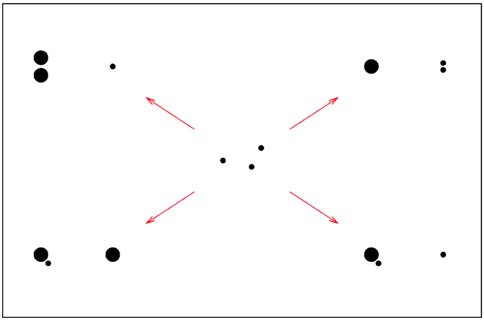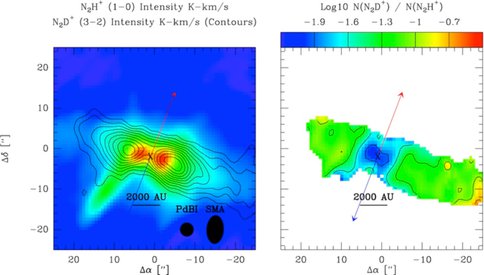2013 Annual Science Report
 University of Hawaii, Manoa
Reporting | SEP 2012 – AUG 2013
University of Hawaii, Manoa
Reporting | SEP 2012 – AUG 2013
Star Formation and the Variable Young Stellar Objects Survey
Project Summary
Planets form in circumstellar disks around young stars in the early stage of star formation and the physical, chemical, and kinematic properties of young stellar objects set the initial conditions of planet formation and affect subsequent evolution of protostars and planets. In this project we perform optical and submillimeter observations to study young stellar objects. In the optical wave-lengths, the Variable Young Stellar Objects Survey (VYSOS) aims at surveying all the major star forming regions visible from Hawaii for variable young stars. A small survey telescope provides shallow observations over a large area of the sky, and a larger telescope allows deeper more detailed observations of smaller regions. VYSOS observations are done robotically. In the submillimeter wave-lengths, high resolution interferometric observations combined with radiative transfer modeling reveal structures of protostellar envelopes and resolve the embedded disks. We also study the spatial distributions of a deuterated molecule relative to its hydrogenbearing counterpart in the envelopes and compare to chemical models. Lastly, brown dwarf triple systems are studied via numerical simulations, and the results show that when such triple systems break up during the protostellar phase, a common result is the formation of a brown dwarf binary.
Project Progress
The VYSOS Project
As in previous years, our major effort during the past year continues to be the VYSOS project. VYSOS (Variable Young Stellar Objects Survey) consists of two telescopes, mounted in Hawaii at Mauna Loa. The purpose of our project is to have these two fully robotic telescopes monitor all star forming regions along the entire Galactic plane within about 2 kpc and visible from Hawaii (i.e. north of declination -40) in order to understand the photometric variability of solar-like young stars. Such variability can have a number of causes, mainly accretion activity, starspots, eclipses by companions or dust clouds, and magnetic reconnection events. Almost nothing is known about the timescales and amplitudes of these phenomena, and the VYSOS project is putting this on a firm footing by monitoring many tens of thousands of young low-mass stars over the next decade or more.
To survey larger swaths of the sky, we have installed a 135 mm apochromatic refractor at the Mauna Loa Observatory. It has a 2.9 × 2.9 degree field and can reach 17th magnitude in 5 min exposures. We are currently performing surveys of large areas of the Milky Way with this telescope. This small but highly efficient telescope will also be used for monitoring bright comets as they enter the inner Solar System, in particular we are starting to monitor the new comet PanSTARRS which is brightening at the moment. Our refractor has already obtained over 100,000 images.
Dynamical Evolution of Multiple Systems
We have continued our studies of unstable triple systems. It is an interesting fact of nature that the motion of two isolated bodies is completely deterministic, while the addition of more bodies, even just one, renders the motion completely chaotic. We have examined the consequences of dynamical interactions in triple systems of three identical protostellar embryos selected from an initial mass function, and we find support for a very simple mechanism in which triple systems of newborn protostellar embryos – embedded in and accreting from a cloud core – break up, ejecting a single body while a binary recoils (Fig. 1). The combination of chaotic dynamics coupled with accretion from a cloud core allow several combinations of stars and brown dwarfs, and we show that if a single embryo fall to the center of the core and grows to a dominant body, then the two remaining embryos will frequently be released as a BD binary. In a forthcoming paper we discuss the detailed processes and statistics of this new pathway to brown dwarf binary formation.
Disks around Embedded Protostars
We have collected high-resolution data of nearby young stellar objects in the embedded phase of star formation using the Combined Array for Research in Millimeter-wave Astronomy and the Sub-millimeter Array. In such an early phase, the protostar is surrounded by a dense collapsing envelope of gas and dust. A circumstellar disk is expected to form if the angular momentum is conserved during the collapse process, but the size and mass of this youngest disk is under debate. Detection of the youngest disk has been difficult due to observational constraints such as insufficient angular resolution or sensitivity; moreover, envelope emission can confuse disk emission in these young embedded sources. In Chiang et al. (2012), we developed a modeling code that allowed an arbitrary envelope density profile, performed a self-consistent temperature solution, solved the radiative transfer of the dust emission, and compared the model with interferometric data at each visibility point. We applied this method to our dual-wavelength data of the embedded object L1157 (Fig. 2, 3), explored the parameter space of theoretical models using Markov chain Monte Carlo in the context of Bayesian inference, and constrained the envelope properties as well as the embedded disk. While the disk at L1157 is smaller than 40 AU and remains unresolved, we made the first detection of a rotationally supported disk in another Class 0 system L1527. The Keplerian disk at L1527 is around 0.007 solar mass and has a radius of around 90 AU. Also, a mass of 0.2 solar mass was estimated for the protostar at L1527 (Tobin et al. 2012; 2013). We have extended our study to more young embedded sources, including some binary or multiple systems, using the Submillimeter Array. Besides probing the envelope and the circumstellar disk, we simultaneously observe molecular lines that trace the bipolar outflow driven by these protostars. By resolving the member protostars of a multiple system, we will constrain the properties of each component as well as study the formation mechanism of young multiple systems.
Spatial Differentiation of N2H+ and N2D+ in Protostellar Envelopes
Earth’s water was formed before the sun was born; the D/H ratio was elevated to a high value in dense, cold cores that later formed the solar system. Icy planetesimals in the outer solar system inherit the D/H ratio of precursor molecules and can bring water to Earth. One interesting deuterated species is H2D+, as reactions with H2D+ in the gas phase offer molecules a primary route to gain their D/H ratios, and product species can freeze out and lock the D/H ratios onto grains that later become planetesimals. H2D+ is mainly formed through the ion-molecule reaction between H2+ and HD, which is efficient at low temperature. As the newborn star heats up the environments, the deuterium fractionation slows down, and thus the D/H ratio drops in molecules such as N2H+ and N2D+. Subsequent chemical evolution is sensitive to this initial D/H ratio set in the early phase of star formation. Spatially resolved observations of deuterated molecules relative to their H-bearing counterparts offer tests of chemical models. In Tobin et al. (2013), we examined the spatial distribution of N2H+ and N2D+ in 12 protostellar envelopes using IRAM-30m. While chemical models predict cospatial column density peaks for N2H+ and N2D+, we unexpectedly found that N2D+ was often spatially offset from N2H+. In particular, the source L1157 shows symmetric N2H+and N2D+ emission and spatial off-set. We obtained interferometric observations and found its N2H+ emission peaks around 1000 AU closer to the protostar than N2D+. A detailed analysis of the spatial distributions of the two molecules was performed using two chemical models, one with infall and one static, but neither model agreed with our observations. However, the observed offset may be explained by an increased CO evaporation temperature due to ice mixing or a temperature-dependent orthotopara ratio of H2. New observations have been proposed in order to confirm the plausibility of these scenarios.
Publications
-
Bally, J., Walawender, J., & Reipurth, B. (2012). DEEP IMAGING SURVEYS OF STAR-FORMING CLOUDS. V. NEW HERBIG-HARO SHOCKS AND GIANT OUTFLOWS IN TAURUS. The Astronomical Journal, 144(5), 143. doi:10.1088/0004-6256/144/5/143
-
Chiang, H-F., Looney, L. W., & Tobin, J. J. (2012). THE ENVELOPE AND EMBEDDED DISK AROUND THE CLASS 0 PROTOSTAR L1157-mm: DUAL-WAVELENGTH INTERFEROMETRIC OBSERVATIONS AND MODELING. The Astrophysical Journal, 756(2), 168. doi:10.1088/0004-637x/756/2/168
-
Correia, S., Duchêne, G., Reipurth, B., Zinnecker, H., Daemgen, S., Petr-Gotzens, M. G., … Ghez, A. M. (2013). Stellar and circumstellar properties of visual binaries in the Orion Nebula Cluster. A&A, 557, A63. doi:10.1051/0004-6361/201220681
-
Dupuy, T. J., Allen, P. R., Kraus, A. L., Biler, B., Blake, C. H., Davison, C., … Zhang, Z. H. (2013). Multiplicity of cool dwarfs. Astronomische Nachrichten, 334(1-2), 36–39. doi:10.1002/asna.201211772
-
Reipurth, B., & Mikkola, S. (2012). Formation of the widest binary stars from dynamical unfolding of triple systems. Nature, 492(7428), 221–224. doi:10.1038/nature11662
-
Reipurth, B., Bally, J., Aspin, C., Connelley, M. S., Geballe, T. R., Kraus, S., … Burgasser, A. (2013). HH 222: A GIANT HERBIG-HARO FLOW FROM THE QUADRUPLE SYSTEM V380 ORI. The Astronomical Journal, 146(5), 118. doi:10.1088/0004-6256/146/5/118
-
Szegedi-Elek, E., Kun, M., Reipurth, B., Pál, A., Balázs, L. G., & Willman, M. (2013). A NEW Hα EMISSION-LINE SURVEY IN THE ORION NEBULA CLUSTER. The Astrophysical Journal Supplement Series, 208(2), 28. doi:10.1088/0067-0049/208/2/28
-
Tobin, J. J., Bergin, E. A., Hartmann, L., Lee, J-E., Maret, S., Myers, P. C., … Friesen, R. (2013). RESOLVED DEPLETION ZONES AND SPATIAL DIFFERENTIATION OF N 2 H + AND N 2 D +. The Astrophysical Journal, 765(1), 18. doi:10.1088/0004-637x/765/1/18
-
Tobin, J. J., Hartmann, L., Chiang, H-F., Wilner, D. J., Looney, L. W., Loinard, L., … D’Alessio, P. (2013). MODELING THE RESOLVED DISK AROUND THE CLASS 0 PROTOSTAR L1527. The Astrophysical Journal, 771(1), 48. doi:10.1088/0004-637x/771/1/48
-
Tobin, J. J., Hartmann, L., Chiang, H-F., Wilner, D. J., Looney, L. W., Loinard, L., … D’Alessio, P. (2012). A ∼0.2-solar-mass protostar with a Keplerian disk in the very young L1527 IRS system. Nature, 492(7427), 83–85. doi:10.1038/nature11610
-
Walawender, J., Reipurth, B., & Bally, J. (2013). OPTICAL AND NEAR-INFRARED SHOCKS IN THE L988 CLOUD COMPLEX. The Astronomical Journal, 146(3), 66. doi:10.1088/0004-6256/146/3/66
- Reipurth, B., Clarke, C., Boss, A., Goodwin, S., Rodriguez, L., Stassun, K., Tokovinin, A. & Zinnecker, H. (2013). Multiplicity in Early Stellar Evolution review for Protostars and Planets VI. In: Beuther, H. (Eds.).
-
PROJECT INVESTIGATORS:
-
PROJECT MEMBERS:
Bo Reipurth
Project Investigator
Ben Berkey
Collaborator
Hsin-Fang Chiang
Collaborator
Leslie Looney
Collaborator
John Tobin
Collaborator
Josh Walawender
Collaborator
-
RELATED OBJECTIVES:
Objective 1.1
Formation and evolution of habitable planets.


